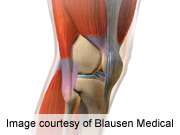Procedure can treat stiff-knee gait in spastic cerebral palsy

(HealthDay)—For individuals with spastic diplegic cerebral palsy and stiff-knee gait with decreased peak knee flexion in the swing phase, distal rectus femoris transfer (DRFT) produces significant and lasting improvements in peak knee flexion, according to research published in the Oct. 3 issue of The Journal of Bone & Joint Surgery.
Thomas Dreher, M.D., of Heidelberg University Clinics in Germany, and colleagues conducted a long-term evaluation of 53 ambulatory patients with spastic diplegic cerebral palsy and stiff-knee gait. Gait analysis and clinical examination were performed before and at one and nine years after surgery. Separate evaluations were conducted for patients who underwent DRFT to correct decreased peak knee flexion in swing phase (C-DRFT) and patients with normal or increased peak knee flexion in swing phase who had prophylactic DRFT (P-DRFT).
One year after surgery, the researchers found that there was significantly increased peak knee flexion in the C-DRFT group, while there was a 15 degree, significant loss in peak knee flexion in the P-DRFT group. At the time of long-term follow-up, there was a slight, nonsignificant increase in peak knee flexion in swing phase in both groups. In the C-DRFT group, there was a significant improvement in the timing of peak knee flexion, which was maintained after nine years. In both groups, knee motion and flexion velocity were increased significantly; this was maintained at long-term follow-up in the C-DRFT group, with no deterioration in the P-DRFT group.
"DRFT is an effective procedure to treat stiff-knee gait featuring decreased peak knee flexion in swing phase and leads to a long-lasting increase of peak knee flexion in swing phase nine years after surgery," the authors write.
More information:
Abstract
Full Text (subscription or payment may be required)
Copyright © 2012 HealthDay. All rights reserved.

















